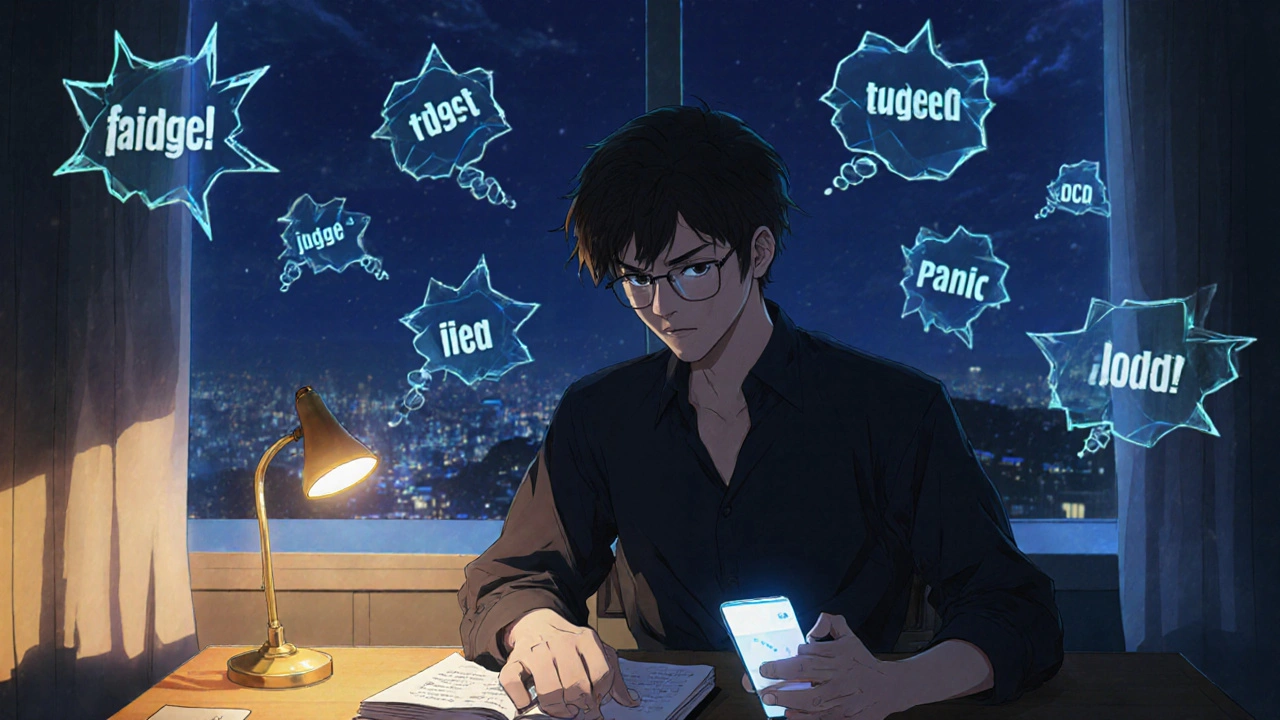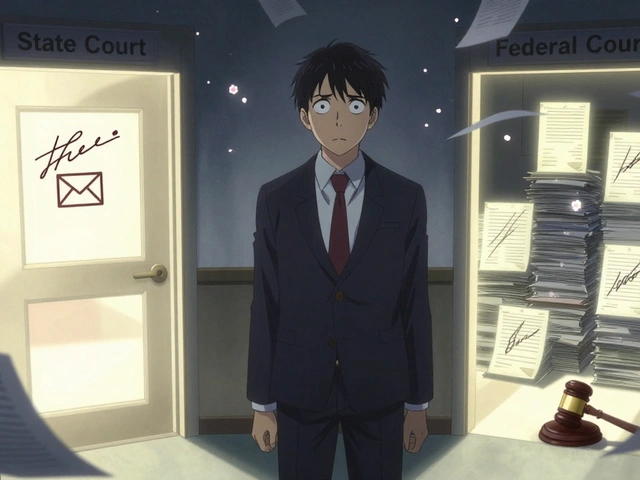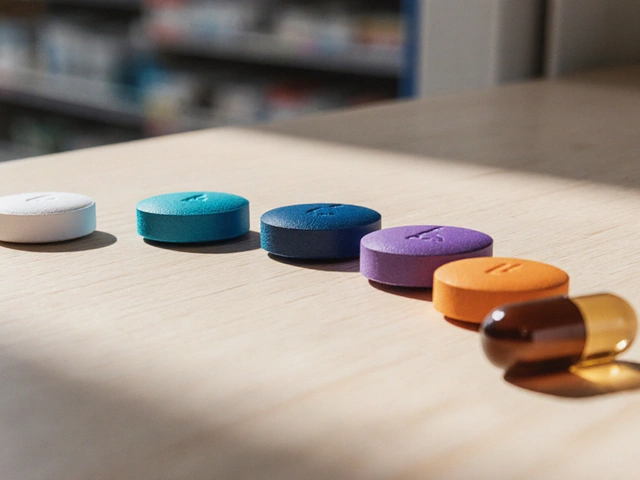More than 19% of U.S. adults experience an anxiety disorder every year. That’s one in five people you know - maybe even you. It’s not just stress. It’s not just being nervous before a presentation. This is persistent, overwhelming fear that shows up whether there’s a real threat or not. It steals sleep, ruins focus, and makes everyday moments feel dangerous. The good news? We know exactly how to treat it - and it works.
What Are the Main Types of Anxiety Disorders?
Anxiety isn’t one thing. It shows up in different ways, and each type has its own pattern. The DSM-5, the standard used by doctors and therapists, recognizes seven main types.Generalized Anxiety Disorder (GAD) is the most common. People with GAD worry constantly - about work, health, bills, even things that haven’t happened yet. The worry isn’t proportional. It’s intense, lasts six months or longer, and feels impossible to turn off. About 3.1% of adults deal with this daily.
Panic Disorder hits like a lightning strike. One minute you’re fine, the next you’re gasping for air, heart pounding at 140 beats per minute, convinced you’re having a heart attack. These panic attacks come out of nowhere. After the first one, the fear of having another becomes its own prison. About 2.7% of adults have this.
Social Anxiety Disorder turns ordinary interactions into minefields. Talking to a cashier, speaking up in a meeting, even eating in public can trigger terror of being judged or humiliated. It’s not shyness. It’s a deep, paralyzing fear of embarrassment. Nearly 7% of adults avoid social situations because of it.
Specific Phobias are intense fears of specific things - spiders, heights, flying, needles. The fear is out of proportion to the actual danger. For 8.7% of adults, one of these phobias limits their life in a measurable way.
Separation Anxiety Disorder isn’t just for kids. Adults can feel extreme distress when separated from loved ones - even if they’re safe. This affects about 4.1% of adults and often goes undiagnosed because people assume it’s just clinginess.
Obsessive-Compulsive Disorder (OCD) used to be grouped with anxiety disorders. Now it’s separate, but the link is clear. Intrusive thoughts - like fearing contamination or harming someone - trigger intense anxiety. To reduce that fear, people perform rituals: washing hands, checking locks, counting steps. These aren’t habits. They’re desperate attempts to feel safe. About 1.2% of U.S. adults live with OCD.
Selective Mutism mostly affects children. They speak normally at home but freeze up in school or public settings. It’s not defiance. It’s extreme anxiety that physically blocks speech. Prevalence is low - under 2% - but it’s often missed until school starts.
What Do the Symptoms Actually Look Like?
Symptoms vary by type, but there’s a common thread: your body thinks it’s in danger - even when it’s not.Physical signs are hard to ignore. Heart racing. Sweating so much your clothes stick to you. Hands trembling. Feeling like you can’t breathe. Dizziness. Nausea. These aren’t random. In panic attacks, 92% of people report sweating. Eighty-seven percent feel trembling. Eighty-three percent struggle to catch their breath. Your body is in full alarm mode.
Cognitive symptoms are just as exhausting. Racing thoughts that won’t stop. Catastrophic thinking - “If I make a mistake, I’ll lose my job, my marriage, everything.” Rumination - replaying every awkward moment from the past week. Trouble focusing on anything else. Eighty-nine percent of people with GAD say they can’t concentrate. Ninety-one percent get stuck in loops of worry.
Emotional symptoms are the heaviest. A constant sense of dread - like something terrible is about to happen. Fear of losing control. Feeling like you’re going crazy. Ninety-five percent of people having a panic attack feel this impending doom. It’s not imagination. It’s a real, chemical response.
For GAD, the diagnosis requires that this worry happens more days than not for at least six months. For panic disorder, you need repeated attacks plus at least a month of fear that another one is coming. These aren’t vague feelings. They’re defined, measurable patterns.
What Treatments Actually Work?
There’s no magic pill. But there are treatments backed by decades of research. And they work - if you stick with them.Cognitive Behavioral Therapy (CBT) is the gold standard. It’s not just talking. It’s structured, skill-based training. You learn to identify distorted thoughts (“Everyone thinks I’m awkward”) and replace them with realistic ones (“Some people notice me, most don’t care”). You practice facing fears gradually - called exposure therapy. For social anxiety or phobias, this means starting small: saying hello to a neighbor, then ordering coffee, then speaking up in a group. Studies show 60-80% of people see major improvement after 12 to 20 sessions.
One person on Reddit wrote: “Started CBT three months ago. Panic attacks dropped from 5-7 a week to 1-2.” That’s not luck. That’s the science.
Medication helps too - especially when anxiety is severe. SSRIs like sertraline and fluoxetine are first-line. They don’t work instantly. It takes 6 to 12 weeks. But 40-60% of people see real relief. They don’t make you “happy.” They take the edge off the fear so therapy can stick.
SNRIs like venlafaxine work similarly. They’re often used if SSRIs don’t help. Both are safer long-term than benzodiazepines (like Xanax or Klonopin), which give quick relief but carry high risks of dependence and brain fog. Doctors avoid them for long-term use for good reason.
Acceptance and Commitment Therapy (ACT) is gaining ground. Instead of fighting thoughts, you learn to notice them without getting pulled in. “I’m having the thought that I’m going to fail,” not “I am going to fail.” This shift reduces the power of anxiety. It’s as effective as CBT for many people.

What About Digital Tools and New Treatments?
Technology is changing the game.FDA-cleared apps like nOCD and Wysa guide users through CBT exercises. In 8 weeks, users report 35-45% symptom reduction - just 20 minutes a day. These aren’t games. They’re clinical tools.
In 2023, the FDA approved zuranolone (Zurzuvae), the first oral drug specifically for postpartum anxiety. In trials, 54% of women went into remission. That’s huge.
Researchers are now using brain scans to identify three distinct “anxiety biotypes.” That means in the next few years, doctors might use an fMRI to predict whether you’ll respond better to CBT or medication - cutting out months of trial and error.
Ketamine-assisted therapy is showing promise for treatment-resistant cases. In 2022 trials, 65% of people saw rapid relief. It’s still experimental, but it’s a breakthrough.
AI tools are learning to predict panic attacks 24 hours in advance - with 87% accuracy. That’s not sci-fi. It’s happening now.
Why Do So Many People Still Struggle?
Knowing what works doesn’t mean everyone gets it.A 2022 VA survey found only 37% of people achieved remission after six months. Why? Two big reasons: access and dropout.
It takes 6 to 8 weeks to get an appointment with a therapist who specializes in anxiety. Many people give up before they start. Others drop out because exposure therapy feels unbearable at first. “I want to quit,” one person wrote. “But I’m glad I didn’t.”
Medication side effects turn people off too. Some feel emotionally numb. Others gain weight or lose libido. That’s why switching to buspirone - a non-addictive anti-anxiety drug - helped one Reddit user.
Insurance limits therapy to 10 sessions. But 12 to 20 are needed for lasting change. That’s a system failure - not a personal one.

What Can You Do Right Now?
You don’t have to wait for a therapist to start feeling better.- Practice diaphragmatic breathing: 5 to 6 breaths per minute. In for 4 seconds, hold for 2, out for 6. Do this for 2 minutes whenever you feel panic rising.
- Write down your worst-case thoughts. Then ask: “What’s the real likelihood this will happen?” Often, it’s less than 5%.
- Use a free app like nOCD or Wysa for 10 minutes a day. Consistency matters more than duration.
- Find a support group. NAMI and ADAA host over 300 weekly groups. Talking to someone who gets it changes everything.
Recovery isn’t linear. Some days will feel worse. That’s normal. Progress isn’t about never feeling anxious. It’s about no longer letting anxiety run your life.
The science is clear. The tools exist. You’re not broken. You’re not weak. You’re dealing with a real, treatable condition - and help is waiting.
Can anxiety disorders go away on their own?
Rarely. While some people may see symptoms lessen over time, untreated anxiety disorders typically persist or worsen. The brain learns to stay in high-alert mode. Without intervention, avoidance behaviors strengthen, and the fear becomes more ingrained. Evidence-based treatments like CBT and medication are proven to reverse these patterns - not just mask symptoms.
Is medication necessary for treating anxiety?
Not always. For mild to moderate cases, CBT alone can be just as effective as medication. But for severe anxiety - especially when it interferes with sleep, work, or daily functioning - medication helps create the mental space needed to benefit from therapy. Many people find the best results come from combining both. The goal isn’t lifelong pills. It’s using medication as a bridge to regain control.
How long does CBT take to work?
Most people start noticing changes in 4 to 6 weeks. By session 12, 60-80% show significant improvement. Full benefits usually take 12 to 20 weekly sessions. The key isn’t speed - it’s consistency. Practicing skills between sessions - like journaling thoughts or doing exposure exercises - makes the difference between temporary relief and lasting change.
Are anxiety disorders genetic?
Yes, genetics play a role. If a close family member has an anxiety disorder, your risk is higher. But genes aren’t destiny. Environmental factors - trauma, chronic stress, early life experiences - interact with biology. You might inherit a sensitive nervous system, but you don’t inherit the disorder. Treatment changes how your brain responds, regardless of your genes.
Can children outgrow anxiety disorders?
Some children do, especially with early support. But half of all anxiety disorders begin by age 11, and without treatment, they often persist into adulthood. Early intervention with CBT tailored for kids significantly improves long-term outcomes. Waiting for them to “grow out of it” can turn a manageable issue into a chronic condition.
What’s the difference between normal worry and an anxiety disorder?
Normal worry is temporary and tied to real events - like stressing before a job interview. Anxiety disorders involve excessive, persistent fear that’s out of proportion to the situation and lasts for months. It interferes with daily life: skipping work, avoiding friends, losing sleep. It’s not about the trigger. It’s about the intensity, duration, and impact.
Do anxiety disorders increase the risk of other health problems?
Yes. Chronic anxiety keeps your body in fight-or-flight mode. This raises blood pressure, weakens the immune system, and increases inflammation. Studies link untreated anxiety to higher risks of heart disease, digestive issues like IBS, and even stroke. Treating anxiety isn’t just about mental health - it’s about protecting your whole body.







Brianna Groleau
November 20, 2025 AT 00:58I’ve been living with GAD for over a decade, and honestly? The part that no one talks about is how exhausting it is to pretend you’re fine. I used to smile through panic attacks in grocery stores, nodding like I was just tired. Then I started CBT and realized-I wasn’t broken, I was just screaming inside and everyone thought I was being dramatic. It took me six months to say the words out loud: ‘I need help.’ And now? I breathe. I sleep. I go to parties without planning my escape route. It’s not perfect, but it’s mine. And if you’re reading this and feeling like you’re drowning? You’re not. You’re just waiting for someone to throw you a lifeline. I’m throwing mine now.
Love you all.
-Brianna
Rusty Thomas
November 20, 2025 AT 16:53OMG YES. I had a panic attack in the Target parking lot last week because I couldn’t find my car. I swear I was 20 feet away. I screamed into my hoodie. A lady brought me a bottle of water. I cried. I’m not okay. I’m not okay. I’m not okay. And I’m glad this post exists because people need to know it’s not just ‘being dramatic.’ I’m not dramatic. I’m terrified. And I’m tired of pretending I’m not.
Also-why is no one talking about how SSRIs make you feel like a zombie for 8 weeks? I cried over a cereal box. I’m not joking. But now I’m 70% better. So… worth it? Maybe.
-Rusty
Sarah Swiatek
November 21, 2025 AT 15:27Let’s be real-CBT isn’t magic. It’s work. Hard, boring, emotionally brutal work. But here’s the thing: your brain is a muscle. And if you’ve been training it to panic at the sound of a door closing, you can retrain it. Not overnight. Not with a pill. But with repetition. With journaling. With saying ‘I’m safe’ even when your heart is trying to escape your chest. I’ve watched clients go from crying in the waiting room to leading group hikes. It’s not about ‘getting over it.’ It’s about learning to carry it differently. And yeah, sometimes you still cry in the shower. But now you know it’s not the end of the world. It’s just Tuesday.
Also-zuranolone? Finally. Took long enough. Postpartum anxiety isn’t ‘baby blues.’ It’s a neurological emergency. And if your doctor says ‘just take a nap,’ fire them.
-Sarah
Dave Wooldridge
November 22, 2025 AT 06:28They’re lying. All of it. The FDA? The NIH? The ‘evidence-based treatments’? This is all a cover-up. Anxiety isn’t a disorder-it’s a signal. The government wants you medicated so you don’t notice the microchips in your phone. The apps? They’re tracking your panic patterns to sell ads. And SSRIs? They’re designed to make you docile. Did you know the original SSRI trials were funded by Big Pharma? Of course you didn’t. They bury the truth. You think your panic attacks are random? They’re triggered by 5G towers. You’re being weaponized. And they want you to believe therapy works because it’s cheaper than paying you to stop asking questions.
Wake up.
-Dave
Rebecca Cosenza
November 23, 2025 AT 09:23Just stop taking meds. Pray more. Exercise. Stop scrolling. You’re weak. That’s it.
❤️
swatantra kumar
November 24, 2025 AT 05:29Bro, I’m from India and we don’t have ‘anxiety disorders’ here-we have ‘problems to solve.’ You sit with your fear, you drink chai, you talk to your auntie, you get a job, you stop overthinking. No apps. No pills. Just life. This post is so American-like, ‘oh no, my heart beat fast, let’s call a therapist and pay $200/hour.’ In Mumbai, we say ‘bhaiya, breathe’ and move on. Also, ketamine? That’s for Hollywood. We have yoga. And chai. And silence. You don’t need an fMRI to know you’re stressed-you just need to stop watching Netflix at 3 AM.
-Swatantra 🙏
Cinkoon Marketing
November 25, 2025 AT 12:31Interesting post. I run a mental health marketing agency in Vancouver and we’ve seen a 400% spike in ‘anxiety content’ engagement since 2021. Honestly? The market is saturated. Everyone’s posting their ‘journey.’ But here’s the thing: most people don’t stick with CBT because they’re not ‘motivated enough.’ And let’s be honest-therapy is a luxury. You need time, money, and emotional bandwidth. Not everyone has that. Maybe we should be talking about systemic solutions-like universal mental health coverage-instead of telling people to ‘try nOCD.’
-Cinkoon
robert cardy solano
November 27, 2025 AT 02:48My therapist told me anxiety is just your body’s way of saying ‘pay attention.’ I used to think that was cheesy. Now I think she’s right. I used to panic before meetings. Now I take a walk. I don’t fight it. I just let it ride. It’s like a wave. You don’t stop it-you ride it. And then it passes.
Still bad days. But fewer.
-Rob
Pawan Jamwal
November 28, 2025 AT 12:11Why are Americans so weak? In India, we work 14 hours a day, live in 10x10 rooms, eat roti with our hands, and still smile. You people have AC, Netflix, Uber Eats, and you cry because your heart beats fast? This is why the world thinks your country is soft. No wonder you need pills. Go lift weights. Eat spicy food. Walk barefoot. Stop being a baby.
-Pawan 💪🇮🇳
Bill Camp
November 28, 2025 AT 17:24They’re lying. The government doesn’t want you cured. They want you dependent. The pharmaceutical companies own the APA. The DSM is a product. CBT? A placebo. You think your panic attacks are real? They’re programmed. They’re triggered by your phone’s Wi-Fi. They’re testing mind control. And you’re buying it. You’re buying the lie. You’re buying the pill. You’re buying the therapy. You’re buying the narrative. Wake up. They’re watching. They’re listening. They’re monetizing your fear.
-Bill
Lemmy Coco
November 29, 2025 AT 10:10just wanted to say… i started using wysa last month and honestly? it’s… kinda helping? i dont know if it’s the breathing exercises or just knowing someone (even if it’s a bot) is listening. i’ve been too scared to talk to a real person. but this? this feels safe. thanks for the post. i needed this.
-lemmy (typo king)
rob lafata
November 30, 2025 AT 22:41You’re all delusional. This isn’t ‘anxiety.’ It’s spiritual decay. You’ve been sold a lie that you’re broken so corporations can profit from your pain. You think CBT helps? It just teaches you to rationalize your suffering. You think SSRIs fix anything? They numb your soul. You think therapy is healing? It’s just a fancy way of paying someone to nod while you cry. The real problem? You’ve lost connection-with God, with nature, with your ancestors. You’re not sick. You’re disconnected. And no app, no pill, no ‘evidence-based’ BS will fix that. Go sit in silence. Go walk barefoot. Go pray. Stop outsourcing your pain to a white coat in a 90-minute session. You’re not broken. You’re betrayed.
-rob lafata
Matthew McCraney
December 2, 2025 AT 05:43Of course you’re anxious. You’re living in a world where your phone watches you, your employer tracks your keystrokes, and your government monitors your search history. You’re not broken-you’re reacting. The system is designed to make you feel powerless. And they want you to think it’s ‘your brain’ that’s faulty. No. It’s your environment. It’s the 24/7 news cycle. It’s the algorithm that feeds you fear. It’s the fact that you can’t afford rent. It’s the fact that your kids are growing up scared. This isn’t ‘anxiety disorder.’ It’s a rational response to a broken world. And until we fix the system, no pill is gonna fix you.
-Matthew